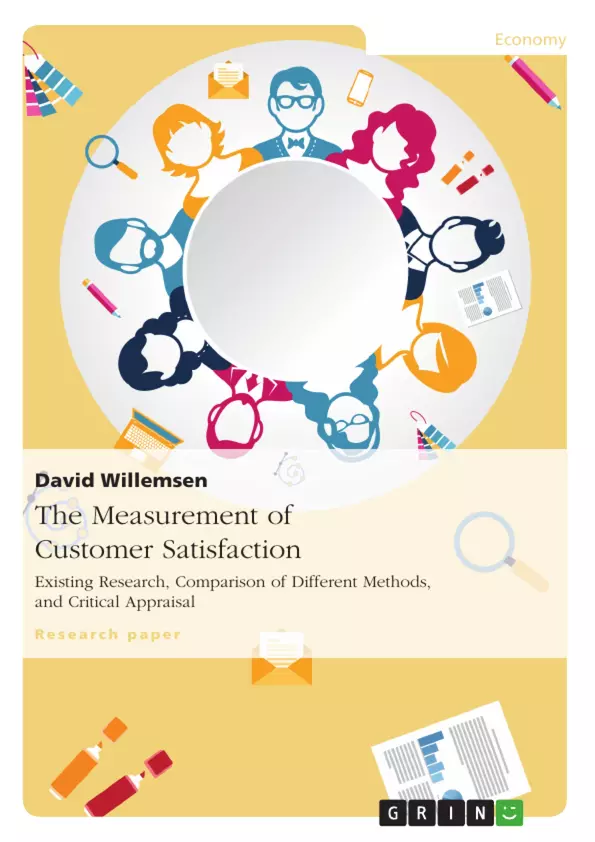Only those companies that fully satisfy their customers will be able to maintain a top market position in the long run. Despite the fact that this rule has been known for a very long time, it has drastically gained in importance in the last years. The reasons are multifarious, but three main aspects can be named: the upswing of customer needs, exacerbating competition, and more complex market conditions. Rising customer demands can best be explained by a growing range of products competing against each other.
In times of fierce competition, companies must deliver optimal products for the purpose of maintaining their competitiveness and strengthening their market positions. To ensure maximum customer loyalty, it is essential to know the status quo regarding the so called customer satisfaction and how consumer needs developed over time.
This thesis presents the current state of research in the field of customer satisfaction measurement. In its macro-structure it can be divided into a theoretical and an empirical part. In the first one, the main measurement and calculation methods are described and discussed with focus on their capability to provide valid and reliable results concerning customer satisfaction. Chapter 2 sets the thematic framework by examining different conceptions of the formation of customer satisfaction. On this basis, a coarse presentation and categorization of prevalent measurement approaches is given.
Not all of those approaches are up to today’s standard of providing valid and reliable measures. Hence, in Chapter 3, only the promising subset of those approaches is further analyzed. Those methods are critically analyzed and assessed with the help of the existing literature. Building on this, a holistic customer satisfaction measurement system is introduced. Subsequently, Chapter 4 addresses the issue of comparability of different customer satisfaction measures and represents the transition from the theoretical to a praxis-based empirical part. Chapter 4.1 focuses on challenges for obtaining comparable data in international measurements. A closer look is taken at the different national CSI models as well as a recently established uniform European approach. Furthermore, study results of individual countries and industries are examined for their similarities and differences. The thesis concludes with a summary of the most important findings and provides an outlook on future developments in the field of customer satisfaction research.
Inhaltsverzeichnis (Table of Contents)
- Introduction
- I
- II
- III
- IV
- Theoretical Framework
- Formation of Customer Satisfaction
- The C/D-Paradigm as a Conceptual Framework
- In-Depth Theories of Satisfaction Formation
- Consequences of Customer Satisfaction
- Overview of Measurement Methodology
- Objective vs. Subjective Methods
- Event- vs. Attribute-Specific Methods
- Indirect vs. Direct Measurement
- One-Dimensional vs. Multi-Dimensional Methods
- Ex Ante/Ex Post vs. Ex Post Measurement
- Subjective Measurement Methods
- Event-Specific Measures
- Critical Incident Technique
- Frequency Relevance Analysis for Problems
- Attribute-Specific Measures
- SERVQUAL
- SERVPERF
- SERVIMPERF
- Customer Satisfaction Index
- National Customer Satisfaction Indices
- Comparison and Critical Evaluation
- Comparability of Customer Satisfaction Measures
- Sources of Error for International Comparisons
- Single- vs. Multi-Dimensional Measures - An Empirical Study
- Data and Study Approach
- Results and Discussion
- Customer Satisfaction across Industries and Countries
- Comparison of National Customer Satisfaction Indices
- The American Customer Satisfaction Index (ACSI)
- The German Customer Satisfaction Barometer
- The Extended Performance Satisfaction Index (EPSI)
- Cross-Industrial Findings
- Cross-National Findings
- Conclusion and Outlook
Zielsetzung und Themenschwerpunkte (Objectives and Key Themes)
This study aims to provide a comprehensive overview of customer satisfaction measurement methods, covering theoretical frameworks, different methodologies, and empirical applications. The work explores the formation and consequences of customer satisfaction, critically analyzing various approaches to measurement, and examining the comparability of different indices across industries and countries.
- Theoretical underpinnings of customer satisfaction formation
- Critical comparison of different customer satisfaction measurement methods
- Analysis of the comparability of customer satisfaction measures across industries and countries
- Exploration of the role of national customer satisfaction indices
- Implications for understanding and managing customer satisfaction
Zusammenfassung der Kapitel (Chapter Summaries)
The first chapter introduces the topic of customer satisfaction measurement and outlines the study's objectives. Chapter 2 delves into the theoretical framework of customer satisfaction formation, exploring the Confirmation/Disconfirmation-Paradigm and various in-depth theories. It then provides a detailed overview of measurement methodology, discussing key considerations such as objective vs. subjective methods, event- vs. attribute-specific measures, and one-dimensional vs. multi-dimensional approaches. Chapter 3 focuses on subjective measurement methods, examining both event-specific and attribute-specific measures. This chapter explores specific techniques such as the Critical Incident Technique, Frequency Relevance Analysis for Problems, and the SERVQUAL, SERVPERF, SERVIMPERF, and Customer Satisfaction Index models. Chapter 4 discusses the comparability of different customer satisfaction measures, addressing potential sources of error for international comparisons. It also presents an empirical study comparing single- and multi-dimensional measures. Chapter 5 investigates customer satisfaction across industries and countries, analyzing national customer satisfaction indices like the American Customer Satisfaction Index (ACSI), the German Customer Satisfaction Barometer, and the Extended Performance Satisfaction Index (EPSI). It examines both cross-industrial and cross-national findings. The conclusion and outlook, which are not summarized here, draw together the key findings and discuss future research directions.
Schlüsselwörter (Keywords)
Customer satisfaction, measurement methods, theoretical frameworks, Confirmation/Disconfirmation-Paradigm, SERVQUAL, SERVPERF, SERVIMPERF, Customer Satisfaction Index, national customer satisfaction indices, comparability, cross-industrial, cross-national, empirical study, international comparisons.
- Arbeit zitieren
- David Willemsen (Autor:in), 2010, The Measurement of Customer Satisfaction, München, GRIN Verlag, https://www.grin.com/document/167014



